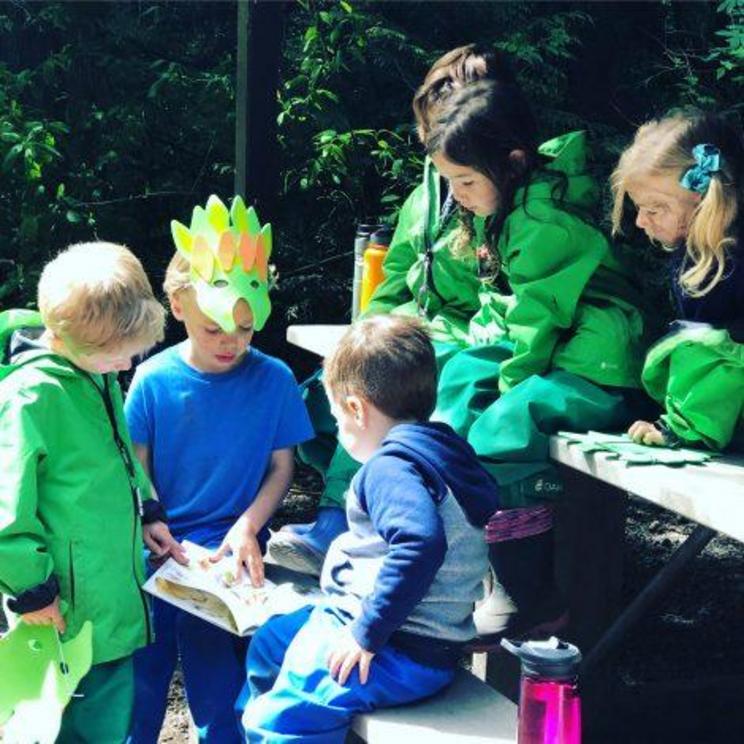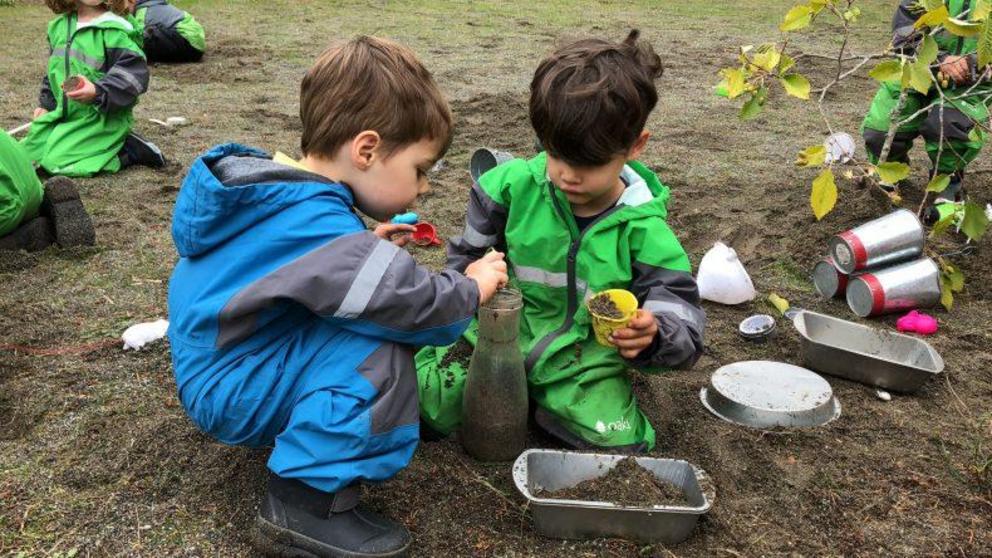Learning in nature: the benefits of Forest School
As I reached the entrance to the group camp site at a local state park, I was greeted by my very muddy 3-year-old son who was wearing a rainsuit, sturdy boots and a giant grin on his face. This was the site of his school, Magnolia Forest Preschool. It was “showcase day” where we had the opportunity to tour the school and see what the kiddos had been working on. He grabbed my hand and started his tour, showing me his favorite spots, introducing me to his friends and pointing out his artwork.
As we came to a small hill, he immediately ran down, jumped into a huge pile of leaves at the bottom and grabbed a small rake to tidy up the pile for the next child. Our next stop was the “kitchen” where he made me dirt coffee and mud pies. We explored moss-covered logs, splashed in puddles and built things out of “loose parts.” He was in his element and I couldn’t help but wish I had gone to this school as a child. It was one of those “I did good” parenting moments where I could pat myself on the back for choosing the ideal preschool for my son.

The Forest School Movement
You may have heard the term “forest school” more frequently in recent years, but what exactly is a forest school? While the concept is still relatively new in the United States, forest schools had already become popularized in Scandinavian countries in the 1950s. The most striking difference between forest school and traditional school is that most, if not all, of the school day is spent outside regardless of the weather. In addition, most forest schools are play-based with children choosing activities that piqued their interest.
Students are encouraged to use their five senses to explore the natural world, stimulating their imagination and sparking their sense of wonder. This is important because research shows that play is likely the most effective way for children to learn life skills and discover their interests and passions. Add this to the scientific evidence showing that being in nature increases cognitive performance while decreasing stress levels and forest schools can provide an advantage for the mental development of a child (even without the use of workbooks and structured learning).
Forest School vs. Traditional School
To paint a better picture of what a forest school looks like, I interviewed the curriculum director and co-owner of Magnolia Forest Preschool, Jenny Stokes. Jenny holds a master’s degree in Early Childhood and Curriculum and Instruction and has over 24 years of teaching experience in various settings from preschool to college. She gave me some insight into what a forest preschool looks like and what the children learn and do in a typical day.
Q. What are the benefits of forest preschool when compared to traditional indoor preschool settings?
A. At forest preschool, children are given freedom to play, the opportunity to explore and learn about the natural environment, and the support they need in learning how to handle risks and cooperate with their peers. Outdoor learning encourages children to think of learning as an ongoing process instead of something done in the classroom. It also encourages problem solving and critical thinking skills. Children develop grit when they must try something repeatedly before they figure out how to solve the problem they face.
There are also studies that show that there are less injuries in an outdoor setting than in an indoor classroom with its confined walls, hard surfaces and sharp corners!
Q. What do children learn in forest preschool?
A. Children at forest school learn boundaries – physical, social and emotional. In this environment, children learn that there are different ways of solving problems and how to manage risks, become self-starters and develop critical thinking skills daily. Children learn pre-reading skills, math concepts, about the natural and physical world, engineering concepts and art. To the trained eye, children can learn just about everything in an outdoor classroom that they learn in a traditional classroom barring rote memorization and how to sit at a desk or in a chair for large swaths of time.
Q. Why is it important for children to have free play in an outdoor setting?
A. Because they are largely able to plan their day based on their interests and needs each day, children become more self-aware, they are able to self-regulate and it sparks their curiosity. Children become intrinsically motivated, develop empathy, learn how to interact with adults and their peers and how to assert their independence, and they are given opportunities to grow in confidence every day.
There are a number of health benefits to playing outside. As they become more active, they build strong bones and lean muscles. They learn physical prowess as they learn to manage different types of terrain, how to navigate obstacles in their path, climb trees and any number of physical problems that they encounter. Even in the winter, they naturally absorb vitamin D, which is proven to help improve moods and create a positive mental attitude. Playing in the dirt supports immunity and risk of myopia, or nearsightedness, is reduced by two-thirds for children with nearsighted parents if they spend more than 14 hours per week outside.
Outdoor play is great for encouraging children’s creativity with all its loose parts and open spaces. Being outside stimulates a child’s imagination and they are not limited to the constraints of toys that have only one purpose. A stick can be a spoon, horse, fishing pole or paint brush – its possibilities are only limited to the child’s imagination.
Q. What does the “classroom” setting look like in a forest preschool?
A. The forest school “classroom” is wherever the children’s desires or interests take them. We teach them safe boundaries in which they must stay, yet they are allowed a great deal of freedom for exploration, gross and fine motor development, and countless learning opportunities. While children in a traditional classroom learn about weather, seasons and the natural world through charts, photographs and books, forest schoolchildren learn through experiencing those things firsthand. They watch the autumn leaves fall from the trees as sunlight lessens and air becomes colder and feel the crunch of the leaves and experience the changing of the colors. They jump in puddles after rain, watch a slug slowly move, leaving its slimy trail behind, and feel the slipperiness of ice underfoot when temperatures drop. Finally, they see springtime buds peeking out of the sparse branches of winter turn in to vibrant green leaves of summer.
Q. What other outdoor learning opportunities do you recommend for parents when forest school isn’t an option?
A. I would encourage parents to invest in clothing and gear for themselves and their children so that they are prepared and comfortable to go outside in any weather. At forest school, our mantra is “there is no such thing as bad weather, only bad clothing” – and it is true! Shop clearance racks, sales, “buy nothing” groups and garage sales for a good pair of gloves, wool socks and layering pieces, as well as fleece and other warm fabrics. There are some really great rain suits on the market to keep children (and adults) dry in most conditions. And then go outside as much as your schedule allows. If you cannot go out every day, try to find time on the weekends for outdoor time. You do not have to go someplace fancy or far from home. Children are happy with a puddle in the back yard if that is all you can manage that day. Hikes and outings are great, but your child will be happy any place he or she can spread out, run around and explore – and of course, connect with groups like “Hike it Baby”!
If your child goes to full-time childcare, talk to the owner about the policy on going outdoors in inclement weather and advocate for your child to be outside as much as possible while they are at school. Furthermore, find a school that values outdoor time and play-based learning. Limit “screen time” and try to trust your child more when they are engaged in physical activity. Give them specific information like “that rock is slippery” or “that hill is steep” instead of saying “be careful” too much. They really do know their limits! Most of all, let children know that it is okay to test their abilities, take risks and get dirty!
There are countless benefits to playing outdoors, but beyond the research and the studies, children deserve the chance to splash in puddles, make mud pies, build forts and run outside for no reason other than it is just plain fun. Even if they occasionally experience a skinned knee, a bug bite or get a splinter, playing outside is a fundamental part of what it means to be a child and the joy and wonder it provides is a big part of what makes childhood so magical.
Check out Magnolia Forest Preschool’s Facebook or Instagram to see how students spend their day learning in nature.
Would you consider sending your kiddos to a forest preschool? Why or why not? Let us know in the comments below!
All photos provided by Magnolia Forest Preschool.
Rebecca Hosley is a transplant Coloradoan living in Washington State with her husband (Derek) and their two boys. She is a Branch Ambassador for the HiB Kitsap Peninsula Branch and is currently working towards exploring as much of the Pacific Northwest as possible before the next move takes her family elsewhere. When she’s not running after her boys on a trail, she enjoys traveling, reading, yoga, and movies. You can follow her family adventures on instagram @FreshAirFam
This article was sourced from non-profit org Hike it Baby

